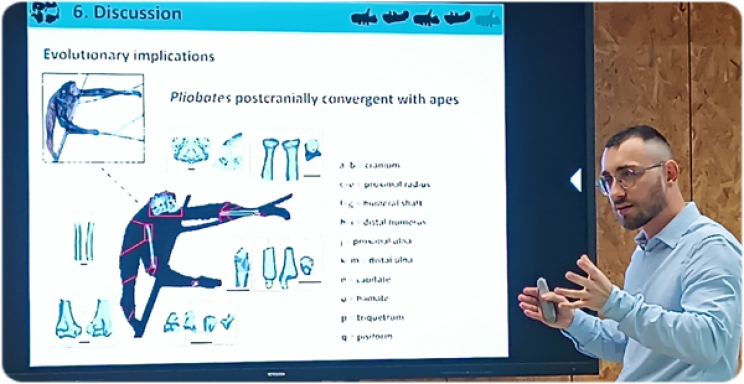Bouchet's doctoral thesis clarifies the relationships of the Miocene primate (11.6 Ma) Pliobates cataloniae, described in 2015 from remains recovered at the Abocador de Can Mata, in the Vallès-Penedès basin. Initially considered a stem hominoid, later studies suggested its belonging to the pliopithecoids, a group of stem catarrhines. Plausible alternative phylogenetic hypotheses included it being a stem hylobatid (the group that includes modern gibbons and siamangs) or a dendropithecid (a family of putative stem catarrhines from East Africa).
The methods used in the study are mainly based on microcomputed tomography scans and landmark-based three-dimensional geometric morphometrics. Among the most significant findings, the study reveals that the morphology of the carotid canal has limited taxonomic and phylogenetic utility for catarrhines and that Pliobates' canal is not particularly similar to that of hylobatids. Additionally, the description of new dental remains indicates that Pliobates is a member of the pliopithecoid family of crouzelids and, therefore, a stem catarrhine rather than a hominoid.
The cladistic analyses conducted from dental and craniodental characteristics confirm that Pliobates is a derived crouzelid, closely related to the poorly known genera Crouzelia and Plesiopliopithecus. Quantitative analyses of the internal tooth morphology (the enamel-dentine junction) support this conclusion. These results refute the initial interpretation of Pliobates as a stem hominoid, which is entirely attributable to postcranial similarities with extant apes, which are the product of evolutionary convergences related to locomotion. Therefore, the doctoral thesis clarifies the phylogenetic relationships of Pliobates cataloniae and has implications for understanding the independent evolution of skeletal characteristics in catarrhines in general.
The thesis, which received the grade of excellent, was supervised by Dr. David M. Alba (ICP), Prof. Salvador Moyà-Solà (ICREA at ICP), and Dr. Amélie Beaudet (University of Cambridge).











